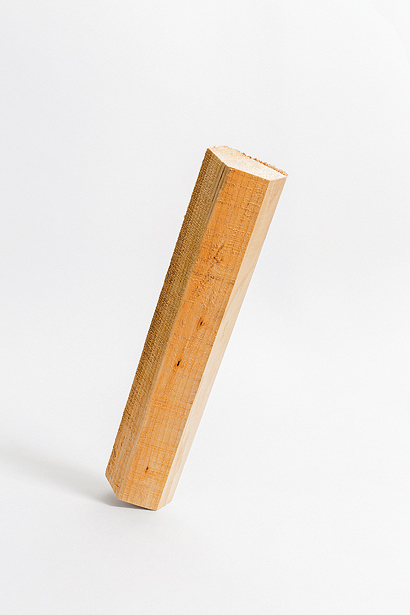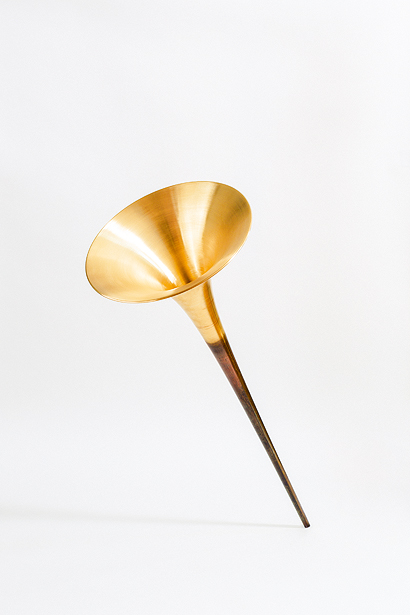|
For their exhibition at the Design Museum, Edward Barber and Jay Osgerby capture a series of objects during the process of manufacture. The show explores the duo’s concerns that society is losing touch with the act of making, as well as the cryptic beauty of half-formed products Surf towards the more remote beaches of digital television, the friendly coves of the Discovery channels somewhere between the interminable repeats of Lovejoy and the encrypted flesh, and you’ll often find a programme called How It’s Made. This hypnotic treasure consists of little more than lingering shots of industrial processes as golf balls or hammers or speedboats are slowly born. No talking heads interrupt and few human hands intrude; the commentary is discreet. It’s soothing, but also captivating. Though maximally practical and pragmatic, based in applied science and honed by the rigours of market economics, modern manufacturing has a thoroughly magical quality. This magic is keenly felt by Edward Barber and Jay Osgerby – designers of the Olympic torch, Icon Award winners, recent OBEs. Sitting with Osgerby in the studio’s Shoreditch office, we watch a video of the making of a diver’s oxygen tank: a piece of material artistry, in which a solid cylinder of aluminium is pressed by a piston into a mould and, heated solely by the friction generated, abruptly squirted into the shape of a tube with a sealed base. “Right from when we started working together, one of the things we enjoyed the most was seeing how things are made, the factory, the workbench, the workshop,” Osgerby says. “And when we start a new project we always insist that we go and see behind the scenes, to see what’s possible, what’s not possible.” “So often we see things in the process, see things in the factory, things that have been discarded along the way, that we find intriguing or even more interesting than the final product,” a disembodied Edward Barber, joining the conversation via FaceTime from New York, continues. “We talk to the technicians and say, ‘What’s this bit here?’ and they say, ‘Oh that’s just the waste product from part of the process’ … and maybe that’s the start of our next project. It’s really, really important to understand how these things are put together. That’s where you can really start to design.”
Cricket bat Among designers it’s quite normal to find an interest in putting on ear protectors and getting up to the ankles in wood shavings in a factory. A love of the detail of realisation is quite common in the profession. But Barber and Osgerby have taken this enthusiasm and turned it into an engrossing exhibition at the Design Museum. In The Making is a collection of unfinished objects, plucked from the assembly line before completion, sometimes as little more than raw material, sometimes with the finishing line tantalisingly close. The Apple MacBook Pro is nothing more than a sheet of aluminium with some holes drilled in it and one edge machined to accommodate a hinge – but it already has Apple’s customary radiused corners. A halogen bulb, paused at 10 per cent completion, is a delicate blue-tinted glass vial that could be an example of Renaissance craftsmanship rather than an object produced in its millions. But it’s the cricket bat that Barber and Osgerby turn to first to explain the purpose of In The Making. At just 10 per cent into its journey, the bat is nothing more than a rough oblong of willow – but one face of it has been cut into a pitch. This simple gesture has given an otherwise undistinguished piece of lumber a crucial first ingredient of cricket-bat-ness: its angled back. “Unless you play cricket, you don’t necessarily know it is a cricket bat until you read the caption, and then you get it instantly,” Barber says. “You can see the realisation on people’s faces.” Like many of the objects, it’s cryptic – the pair at first discussed concealing the captions and turning the whole exhibition into a guessing game – yet at the same time revealing, telling us something about the essence of the product it will become. “In a very few steps of manufacturing, that piece of wood ceases being a tree and starts being a cricket bat,” Osgerby says. “What Ed and I always fall in love with is discovering the very simple way in which things can change between being one thing and another – and the signs and the symbols that let you know what something is, without it being overt.” One of the most mysterious yet beguiling objects in the exhibition is a large blob of obviously highly refined material with a sinister shine – under the spotlights in the Design Museum, it is both dazzling and inky black. It is impossible to identify, but turns out to be the firt step along the path to making a silicon wafer, the basis of the integrated circuit, which in turn is the basis of all modern electronics. In other words, what it is is the fundamental substrate of 21st-century life, included “not so much because it’s a beautiful thing but because of what that element has done for the world”, Osgerby says. Underlying this desire to reveal the hidden before-life of objects is a concern that our collective connection to the processes that underpin and provision our civilisation is being lost. Both men talk about the traditions of making in their families, how they saw their parents and grandparents creating things with their hands and the importance of that experience. “When you buy a cricket bat, you should have some understanding of what went into making it exist,” Osgerby says. “You get the sense that our children’s generation is growing up to click an icon and get the Amazon package delivered. We’re so far removed from the act of making that in a way an object doesn’t have a great deal of intrinsic value because you don’t understand what went into producing it.”
Bank note “If people have a little understanding of how it’s made, they’ll maybe appreciate the object a little more, instead of just having it a few years and throwing it out,” Barber adds. Even a cricket bat, at first look a simple chunk of wood, has a surprisingly complicated story, enough to foster new-found respect for the finished article. “People have been fascinated, more so than we thought they would be.” The pair credits the artist Cornelia Parker with the idea of showing proto-products. In the 1990s Parker experimented with “pre-empted objects”, creating the memorable 1995 work Embryonic Firearms, two steel forms taken from the process of making a pistol, nothing more than crude gun shapes. “Not only is the making process revealed but I like the fact that something that’s potentially dangerous has just been stopped,” Osgerby says. Exhibits are all common and familiar items from everyday life, stopped just at the point they become recognisable, and have been selected to show a diversity of manufacturing techniques – although as Osgerby says, “actually at the root of it all there aren’t so many [techniques] – there really aren’t. When you get down to the beginning of the manufacturing process there are only a few ways of skinning a cat – extrusion, stamping, laser-cutting, moulding.” One early idea was to show the moulds different objects are made in, but in the end moulding was a technique that’s mostly avoided because, Barber says, “You have nothing and then you have something very quickly. It’s not really that interesting.” One exception to that rule is Barber Osgerby’s own injection-moulded Tip Ton chair for Vitra, which debuted in 2011. With Vitra’s cooperation, the pair were able to exercise second-by-second control over exactly when the injection was halted, resulting in a chair that lacks a good deal of its seat, showing how plastic flows through the mould. Another moulded product is the Axor mixer tap, a baffling object resembling an Eduardo Paolozzi bronze – it takes some time to identify where two tap shapes can be found in the mass of metal. “Once you figure out there are two taps, you think ‘What a waste of material’,” Osgerby says, “but of course they just bandsaw off the bits and put them straight back in the crucible and reuse them. That’s the great thing about these metal products, they’re infinitely useful.” While the tap could be chucked back into the crucible tomorrow, sometimes stopping a process before it is complete can have interesting side-effects that illustrate the material phenomena that go into their creation. The Staffordshire Blue brick was paused just after wet clay was extruded through a form but before the resulting rectangular salami was sliced into individual piece and fired. Denied the heat of the kiln, the extruded column is drying – and dying. One of the people who assisted Barber and Osgerby in putting the show together “basically spent her Christmas holiday watering the brick so that it didn’t dry out”, Osgerby says. “It was losing all of its moisture, and it just can’t hack it basically.” But to no avail – it is warping out of shape, and has spectacularly cracked.
Silicon wafer The brick is interesting but no one could accuse it of being beautiful. By contrast, the aborted marble is exquisite. Few can have failed to wonder how these delicate glass orbs with coloured swirls are made – to see that the process resembles “a glass version of seaside rock”, with the sphere twisted off a stick, is delightful. Barber highlights the Thonet chair back, a bentwood U, not just for its grace as an object but “because it’s the first industrially produced piece of furniture, and it’s still being produced exactly the same way it always was, so as a furniture designer I think that’s one of the most brilliant pieces of design ever.” The silver fork with conjoined tines, which Osgerby calls “the dieter’s fork”, Barber finds “very frustrating to look at, actually. Not because you can’t use it but because it’s so wrong – it really annoys me. That’s part of the reason I liked it – it really creates a reaction in me, it makes me want to cut the end off it.” “That’s because you’re thinking of a plate of spaghetti arrabiata and you want something to eat it with,” Osgerby adds. Maybe they’re both thinking of spaghetti. Pasta was one of the many items – along with the oxygen tank, sadly – that the pair tried to get into the show, but couldn’t. “The pasta companies thought we were taking the piss,” Osgerby says. Another regretted omission is the humble razor blade: “Even after all this time, they consider their processes to be so secret.” Barber and Osgerby’s rummaging around in factories feeds back into their work in unexpected but useful ways. Osgerby describes a shelving project for Vitra with a rotating divider component. “It had a very dry, clicky sound,” he says. “It didn’t feel right in any way.” It was a place where the user interacted directly with the product, feeling it with the hand, so they searched for a better motion. “In the end we found a mechanism that’s used in washing machine axles that’s incredibly smooth but has a really nice resistance – it feels very controlled, very German. So there we are – one minute we’re at Vitra, working on a furniture project, and the next we’re taking washing machines apart.” In The Making is at the Design Museum in London until 5 May.
A marble, still attached to its glass cylinder
French horn This article was first published in Icon’s May 2014 issue: Factories, under the headline “Do you mind if we interrupt?”. Buy old issues or subscribe to the magazine for more like this |
Words Will Wiles
Portraits Steve Double and Florence Montmare |
|
|




















